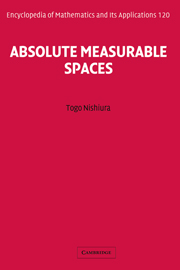Book contents
- Frontmatter
- Contents
- Preface
- Acknowledgements
- 1 The absolute property
- 2 The universally measurable property
- 3 The homeomorphism group of X
- 4 Real-valued functions
- 5 Hausdorff measure and dimension
- 6 Martin axiom
- Appendix A Preliminary material
- Appendix B Probability theoretic approach
- Appendix C Cantor spaces
- Appendix D Dimensions and measures
- Bibliography
- Notation index
- Author index
- Subject index
6 - Martin axiom
Published online by Cambridge University Press: 14 May 2010
- Frontmatter
- Contents
- Preface
- Acknowledgements
- 1 The absolute property
- 2 The universally measurable property
- 3 The homeomorphism group of X
- 4 Real-valued functions
- 5 Hausdorff measure and dimension
- 6 Martin axiom
- Appendix A Preliminary material
- Appendix B Probability theoretic approach
- Appendix C Cantor spaces
- Appendix D Dimensions and measures
- Bibliography
- Notation index
- Author index
- Subject index
Summary
Except for two statements in the earlier chapters that used the continuum hypothesis (abbreviated as CH), all the others used only what is now called the usual axioms of set theory – namely, the Zermelo–Frankel axioms plus the axiom of choice, ZFC for short. In this final chapter a look at the use of the continuum hypothesis and the Martin axiom in the context of absolute null space will be made. The discussion is not a thorough coverage of their use–the coverage is only part of the material that is found in the many references cited in the bibliography.
It has been mentioned many times that absolute null space is an example of the so–called singular sets. This example is a topological notion in the sense that it does not depend on the choice of a metric:F Two other metric independent singular sets will be included also. They are the Lusin set and the Sierpiński set in a given ambient space X.With regards to ambient spaces, it is known that “absolute null subspace of an ambient space X” is equivalent to “universally null set in X.”
The chapter is divided into four sections. The first is a rough historical perspective of the use of the continuum hypothesis in the context of universally null sets in a given space X. The second concerns cardinal numbers of absolute null spaces. The third is a brief discussion of the Martin axiom and its application to the above mentioned singular sets.
- Type
- Chapter
- Information
- Absolute Measurable Spaces , pp. 157 - 178Publisher: Cambridge University PressPrint publication year: 2008

